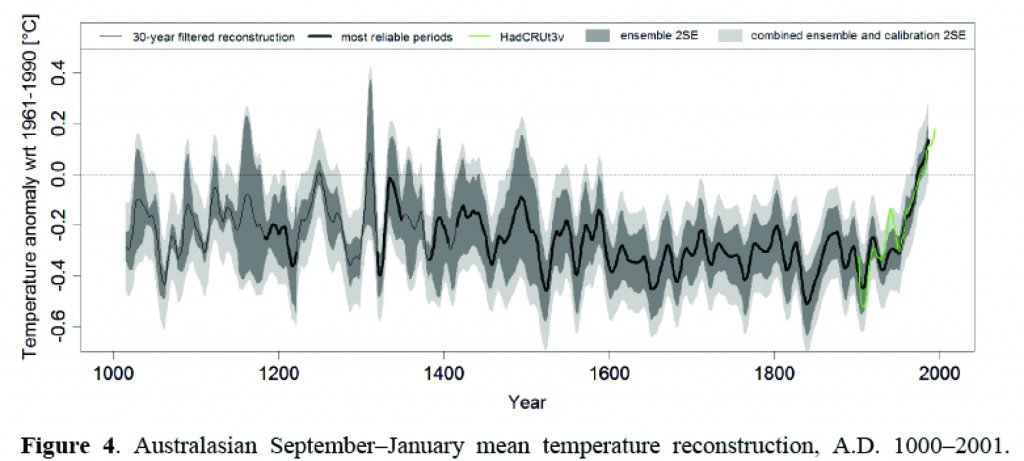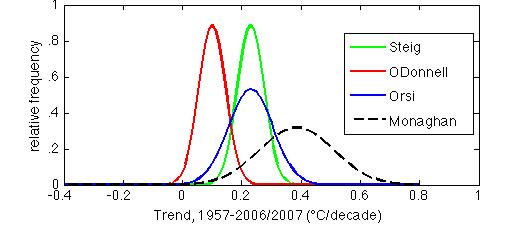Fresh Hockey Sticks From The Southern Hemisphere
By Eric Steig
22 May, 2012
Realclimate.org
In the Northern Hemisphere, the late 20th / early 21st century has been the hottest time period in the last 400 years at very high confidence, and likely in the last 1000 – 2000 years (or more). It has been unclear whether this is also true in the Southern Hemisphere. Three studies out this week shed considerable new light on this question. This post provides just brief summaries; we’ll have more to say about these studies in the coming weeks.
First, a study by Gergis et al., in the Journal of Climate uses a proxy network from the Australasian region to reconstruct temperature over the last millennium, and finds what can only be described as an Australian hockey stick. They use an ensemble of 3000 different reconstructions, using different methods and different subsets of the proxy network. Worth noting is that while some tree rings are used (which can’t be avoided, as there simply aren’t any other data for some time periods), the reconstruction relies equally on coral records, which are not subject to the same potential (though often-overstated) issues at low frequencies. The conclusion reached is that summer temperatures in the post-1950 period were warmer than anything else in the last 1000 years at high confidence, and in the last ~400 years at very high confidence.

Gergis et al. Figure 4, showing Australian mean temperatures over the last millennium, with 95% confidence levels.
Second, Orsi et al., writing in Geophysical Research Letters, use borehole temperature measurements from the WAIS Divide site in central West Antarctica, a region where the magnitude of recent temperature trends has been subject of considerable controversy. The results show that the mean warming of the last 50 years has been 0.23°C/decade. This result is in essentially perfect agreement with that of Steig et al. (2009) and reasonable agreement with Monaghan (whose reconstruction for nearby Byrd Station was used in Schneider et al.,( 2012). The result is totally incompatible (at >95% confidence) with that of O'Donnell et al. (2010).

Probability histograms of temperature trends for central West Antarctica (Byrd Station [80°S, 120°W; Monaghan] and WAIS Divide [79.5°S, 112°W; Orsi, Steig, O'Donnell]), using published means and uncertainties. Note that the histograms are normalized to have equal areas; hence the greater height where the published uncertainties are smaller.
This result shouldn’t really surprise anyone: we have previously noted the incompatibility of O’Donnell et al. with independent data. What is surprising, however, is that Orsi et al. find that warming in central West Antarctica has actually accelerated in the last 20 years, to about 0.8°C/decade. This is considerably greater than reported in most previous work (though it does agree well with the reconstruction for Byrd, which is based entirely on weather station data). Although twenty years is a short time period, the 1987-2007 trend is statistically significant (at p<.1), putting West Antarctica definitively among the fastest-warming areas of the Southern Hemisphere -- more rapid the the Antartic Peninsula over the same time period.
We and others have shown (e.g. Ding et al., 2011), that the rapid warming of West Antarctica is intimately tied to the remarkable changes that have also occurred in the tropics in the last two decades. Note that the Orsi et al. paper actually focuses very little on the recent temperature rise; it is mostly about the "Little-ice-age-like" signal of temperature in West Antarctica. Also, these results cannot address the question of whether the recent warming is exceptional over the long term -- borehole temperatures are highly smoothed by diffusion, and the farther back in time, the greater the diffusion. We'll discuss both these aspects of the Orsi et al. study at greater length in a future post.
Last but not least, a new paper by Zagorodnov et al. in The Cryosphere, uses temperature measurements from two new boreholes on the Antarctic Peninsula to show that the decade of the 1990s (the paper state “1995+/-5 years”) was the warmest of at least the last 70 years. This is not at all a surprising result from the Peninsula — it was already well known the Peninsula has been warming rapidly, but these new results add considerable confidence to the assumption that that warming is not just a recent event. Note that the “last 70 years” conclusion reflects the relatively shallow depth of the boreholes, and the fact that diffusive damping of the temperature signal means that one cannot say anything about high frequency variability prior to that. The inference cannot be made that it was warmer than present, >70 years ago. In the one and only century-long meteorological record from the region — on the Island of Orcadas, just north of the Antarctica Peninsula — warming has been pretty much monotonic since the 1950s, and the period from 1903 to 1950 was cooler than anything after about 1970 (see e.g. Zazulie et al., 2010). Whether recent warming on the Peninsula is exceptional over a longer time frame will have to await new data from ice cores.
References
1. J. Gergis, R. Neukom, S.J. Phipps, A.J.E. Gallant, and D.J. Karoly, "Evidence of unusual late 20th century warming from an Australasian temperature reconstruction spanning the last millennium", Journal of Climate, 2012, pp. 120518103842003-. DOI.
2. A.J. Orsi, B.D. Cornuelle, and J.P. Severinghaus, "Little Ice Age cold interval in West Antarctica: Evidence from borehole temperature at the West Antarctic Ice Sheet (WAIS) Divide", Geophysical Research Letters, vol. 39, 2012. DOI.
3. E.J. Steig, D.P. Schneider, S.D. Rutherford, M.E. Mann, J.C. Comiso, and D.T. Shindell, "Warming of the Antarctic ice-sheet surface since the 1957 International Geophysical Year", Nature, vol. 457, 2009, pp. 459-462. DOI.
4. D.P. Schneider, C. Deser, and Y. Okumura, "An assessment and interpretation of the observed warming of West Antarctica in the austral spring", Climate Dynamics, vol. 38, 2012, pp. 323-347. DOI.
5. R. O’Donnell, N. Lewis, S. McIntyre, and J. Condon, "Improved Methods for PCA-Based Reconstructions: Case Study Using the Steig et al. (2009) Antarctic Temperature Reconstruction", Journal of Climate, vol. 24, 2011, pp. 2099-2115. DOI.
6. Q. Ding, E.J. Steig, D.S. Battisti, and M. Küttel, "Winter warming in West Antarctica caused by central tropical Pacific warming", Nature Geoscience, vol. 4, 2011, pp. 398-403. DOI.
7. V. Zagorodnov, O. Nagornov, T.A. Scambos, A. Muto, E. Mosley-Thompson, E.C. Pettit, and S. Tyuflin, "Borehole temperatures reveal details of 20th century warming at Bruce Plateau, Antarctic Peninsula", The Cryosphere Discussions, vol. 5, 2011, pp. 3053-3084. DOI.
8. N. Zazulie, M. Rusticucci, and S. Solomon, "Changes in Climate at High Southern Latitudes: A Unique Daily Record at Orcadas Spanning 1903–2008", Journal of Climate, vol. 23, 2010, pp. 189-196. DOI.
Eric Steig is an isotope geochemist at the University of Washington in Seattle. His primary research interest is use of ice core records to document climate variability in the past. He also works on the geological history of ice sheets, on ice sheet dynamics, on statistical climate analysis, and on atmospheric chemistry.. He has served on the national steering committees for the Ice Core Working Group, the Paleoenvironmental Arctic Sciences initiative, and the West Antarctic Ice Sheet Initiative, all sponsored by the US National Science Foundation. He was a senior editor of the journal Quaternary Research, and is currently director of the Quaternary Research Center. He has published more than 60 peer-reviewed articles in international journals.
Due to a recent spate of abusive, racist and xenophobic comments we are forced to revise our comment policy and has put all comments on moderation que.


